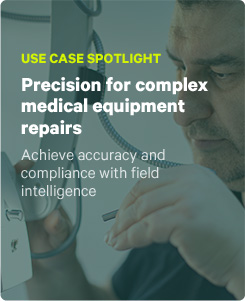Losing a Technician Means Losing More Than a Headcount
Field service organizations are in a high-stakes balancing act: meet customer expectations, scale efficiently, and do it all while navigating a talent crisis. It’s tempting to see technician turnover as a matter of personnel. Hire, train, replace. But that lens misses the deeper cost. Every time a seasoned field technician walks out the door, they take years of hard-earned knowledge with them.
This isn’t just about technical know-how. It’s about context. It’s the difference between knowing how to fix a piece of equipment and knowing that this client’s equipment has a recurring voltage issue in extreme humidity, or that a specific workaround, not outlined in official product documentation as a known fix, reduces customer downtime by hours. That knowledge is rarely documented. It exists in habits, in heads, and in informal conversations — until it’s gone.
The Hidden Cost of Knowledge Loss
When experienced techs leave, continuity suffers. Successors step into complex environments without access to the nuanced decisions that have shaped workflows and service history. Job completion takes longer. Fix rates decline. Customers feel the difference, not just in delays, but in the growing sense that your team is starting from scratch on problems they thought were already solved.
And the learning curve isn’t getting any shorter. Modern field service roles demand more technical fluency, not less. As products become more sophisticated and remote diagnostics grow in complexity, relying on informal, mentor-based knowledge transfer becomes unsustainable. Tribal knowledge doesn’t scale, and it doesn’t survive turnover either.
The Problem Isn’t People, It’s Infrastructure
Organizations may scramble to fill vacancies or beef up training programs, but the root issue often lies elsewhere. Knowledge isn’t centralized. The wisdom your best field techs develop over years of diagnostic work isn’t captured in a consistent, accessible way. It lives in notes, texts, memory, or shared only verbally in one-on-one interactions.
That makes your business vulnerable. If the information needed to do the job is in a person’s head rather than in a system, then each departure is a disruption. Multiply that across dozens or hundreds of technicians, and the operational risk becomes systemic.
Digital Workflows: From People-Dependent to Process-Driven
Shifting to digital workflows is the first step in solving this problem. Rather than relying on individuals to manually recall procedures or carry tribal knowledge forward, you embed that knowledge into standardized, mobile-first workflows. This approach doesn’t just streamline operations, it democratizes expertise.
With TrueContext, frontline workers are guided through adaptive, context-rich workflows that adapt to specific job types, asset models (especially known customer equipment), customer configurations, and regulatory requirements. What once lived in the minds of your most tenured employees becomes embedded into the fabric of your daily operations, codified as standard process.
But even structured workflows can’t cover every edge case. Sometimes, a technician still needs to pull up a specific diagram, a site-specific procedure, or a piece of rare documentation. They need it fast, without digging through folders or calling HQ. That’s where the TrueContext Resource Library comes in.
The Resource Library: Field-Ready Knowledge at Your Fingertips
The Resource Library in TrueContext is more than just a repository. It’s an embedded, searchable, field-accessible layer of institutional knowledge designed to augment every technician’s decision-making in real time. Here’s how it strengthens your knowledge infrastructure:
- Centralized documentation: Store all relevant materials — manuals, diagrams, safety protocols, service bulletins — in a single, governed location.
- Embedded access: Surface relevant documents directly within workflows, based on job type, location, or other context-aware triggers.
- Offline availability: Field techs can access materials even when working in remote locations without connectivity.
- Multilingual support: Ensure consistency across teams working in different regions and languages.
- Version control: Maintain up-to-date materials and instantly reflect updates across your entire technician base.
Rather than being an external reference point, the Resource Library becomes an integral part of service execution. Whether a technician is onboarding for the first time or handling a rare edge case, the guidance they need is right there — integrated, contextual, and always current.
Future-Proofing Field Operations
By turning knowledge into a shared resource instead of a personal asset, organizations create resilience. New hires come up to speed faster. Seasoned pros still benefit from structured reference material. Customers experience consistency, no matter who’s on the job.
The long-term impact is transformative. You reduce escalations because fewer things go wrong the first time. You protect service quality in the face of turnover. You mitigate the risk of losing technical expertise that can’t easily be replaced. And most importantly, you scale with confidence, knowing that your operational excellence doesn’t depend on any single individual.
Stop Losing Knowledge and Start Building Infrastructure
Turnover isn’t going away. The aging workforce, growing complexity of field operations, and competition for skilled talent all make it a persistent challenge. But turnover doesn’t have to mean starting over.
By shifting from a people-dependent to a process-driven approach, and by integrating knowledge capture directly into your workflows, you make every technician part of a scalable, resilient system. The TrueContext platform, with features like dynamic workflows and the Resource Library, empowers your teams to work smarter, faster, and with far greater consistency, regardless of experience level.
Because at the end of the day, what keeps your operations running isn’t just who’s on the job — it’s what they know, and how easily they can access it.




